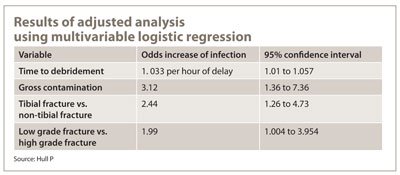Greater infection risk with delayed debridement of high grade open fractures
Presence of contamination, fracture grade and tibial fractures influenced infection risk.
Delay to debridement for high grade open fractures — especially those in the tibia — increases the probability of severe infections, according to a study presented by Peter Hull, FRCS, at the British Orthopaedic Association and the Irish Orthopaedic Association Combined Meeting 2011.
“Severe, open, contaminated tibial fractures should be debrided as a surgical emergency and other open fractures should be debrided urgently,” Hull said during his presentation.
He noted that previous published studies often reiterated that open fractures require debridement within 6 hours.
Time to debridement
“Debridement of open fractures has long been considered to be a surgical emergency, but is there really any evidence of this?” Hull asked.
To answer this question, Hull and researchers at Sunnybrook Health Sciences Centre in Toronto, studied all open fracture cases during a 4-year period. They examined 364 patients with 459 open fractures and followed up with 90% of patients at an average of 1 year.

The investigators used the time to surgical debridement as a continuous and categorical variable, and used 6 hours and 12 hours of delay as cut-off time points. Study controls included fracture grade, anatomic site of the fracture and significant contamination.
The team found infection in 15% to 20% of grade 3B and 3C fractures, 5% to 10% of grade 2 and 3A fractures and discovered no infection in grade 1 fractures. Infection rates at the 6-hour and 12-hour cut-offs were not statistically significant.
Confounding factors
After controlling for confounding variables such as fracture grade, presence of contamination and whether the patient suffered a tibial fracture, a multivariable analysis revealed a two times higher risk of infection with higher grade fractures, a 2.5 times higher risk in cases of tibial fracture and a three times greater risk in cases with gross contamination. The investigators also found that every hour of delay meant a 1.03 times increased risk for infection. When the team delayed debridement for 12 hours, the chance for infection increased 1.36 times or 36%.
“Is that bad?” Hull asked. “It depends on what type of fracture you have. If you have a low grade noncontaminated forearm fracture, your chance of infection is around 2%. You times that by 1.36%, and it goes up to 2.5% to 3% so it is probably not that important.”
However, Hull said that the chances for infection were highest for open contaminated tibial fractures. Chance of infection for a high grade contaminated tibial fracture that forgoes debridement for 12 hours increased from 35% to 50%, he said.– by Renee Blisard
Reference:
- Hull P, Jenkinson R, Essue J, et al. Delayed debridement increases risk of deep infection among high grade open fractures. Presented at the British Orthopaedic Association and the Irish Orthopaedic Association Combined Meeting 2011. Sept. 13-19. Dublin.

- Peter Hull, FRCS, can be reached at Cambridge University Hospital, Cambridge; email: hullpd@gmail.com
- Disclosure: Hull has no relevant financial disclosures.
This is a nice study illustrating the importance of early debridement in high grade open fractures. Interestingly, their data showed no difference when analyzed at two time points, 6-hour and 12-hour delays, but when time delay was analyzed as a continuous variable, then each hour delay represented an increased risk of infection (reminiscent of the surviving sepsis message of mortality rates increasing hourly if treatment is delayed).
Obviously this only addresses the central issue of time to surgery and infection risk; one could postulate in a similar manner that this would also potentially represent a saving in terms of length of stay in hospital and possibly a difference in antibiotic durations and antibiotic free days.
— Robert Townsend, MBCHB, MSc, DTMH, FRCPath
Sheffield Teaching Hospitals
Sheffield, United Kingdom
Disclosure: Townsend speaks on orthopaedic infections for Biomet and
is clinical director, Orthopaedic Microbiology Service.

